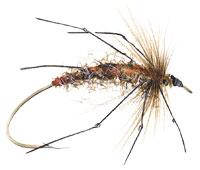Kingdom: Animalia|
Phylum Arthropoda
Class: Insecta
Order: Diptera
Suborder: Nematocera
Infraorder: Tipulomorpha
Superfamily: Tipuloidea
Family: Tipulidae
The Tipulidae family of flies is the biggest in the world, about 15,000 species worldwide and 600 species in New Zealand. Catalogue of the Craneflies of the World
New Zealand flies range up to 30 mm in body length that of the NZ native the Giant Crane Fly (Austrotipula hudsoni). In appearance, crane flies seem long and gangly, with very long legs, and a long slender abdomen. The wings are often held out when at rest, unlike most flies, crane flies are weak and poor fliers with a tendency to "wobble" in unpredictable patterns during flight.
Despite their common names, crane flies do not prey on mosquitoes as adults, nor do they bite humans. Adult crane flies feed on nectar or they do not feed at all; once they become adults, most crane fly species live only to mate and die. Adults feed on nectar. Their larvae live in rotting plants and in the soil. They do not bite humans.
These flies are interesting because they have halteres which are small knobbed structures found as a pair on some two-winged insects. They are flapped rapidly and function as accelerometers to help the insect maintain stability in flight. Halteres operate as vibrating structure gyroscopes. They flap up and down as the wings do and tend to maintain their plane of vibration. If the body of the insect changes direction in flight or rotates about its axis, a Coriolis force develops on the vibrating haltere, deflecting it from its stroke plane. The animal detects this deflection with sensory organs known as campaniform sensilla located at the base of the halteres. The planes of vibration of the two halteres are orthogonal, each forming an angle of about 45 degrees with the axis of the insect. Halteres thus act as a balancing and guidance system, helping these insects to perform their fast aerobatics. In addition to providing rapid feedback to the muscles steering the wings, they also play an important role in stabilizing the head during flight.
Catalogue of the Craneflies of the World
Cranefly (might be Hudsonia heterogama)

Another cranefly. Halteres they can be seen on each side of the wings in a photo below Click photo for enlargement.

Crane flies mating

[http://ketenewplymouth.peoplesnetworknz.info/image_files/0000/0009/9928/Tipuloidea_cranefly__2_.JPG
]
[http://ketenewplymouth.peoplesnetworknz.info/image_files/0000/0009/9923/Tipuloidea_cranefly__1_.JPG
]
The text and photo below is courtesy of http://www.nzfishing.com/Lures/FliesAndLures/CraneFly.htm
"A trout lure tied like a crane fly. rout fisherman uses a fly tied like a crane fly, is a very effective pattern to use during the warm months when numbers of crane flies are around the water. Even when trout are feeding actively on other insects they seem unable to resist a crane fly lure as it floats by."
Pupae of a Crane-fly. Many crane-fly larvae are aquatic and are an important food source for our native fishes and trout
Thanks to Wikipedia for text and information http://creativecommons.org/licenses/by-sa/3.0/







